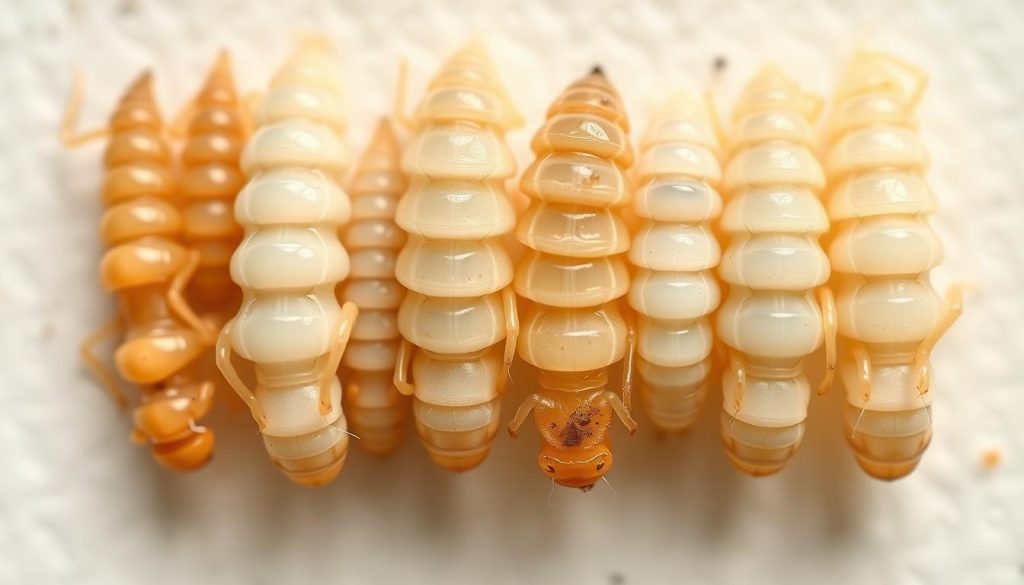Termite larvae identification is vital for safeguarding your home from costly damage. These tiny insects form the core of termite colonies. Spotting them early can prevent serious pest problems1.
Termite larvae are tiny, measuring about 1/10 inch long. They have soft white bodies that look like worker termites1. Their small size makes them hard to spot without training.
These young insects hide in complex termite mounds. The mounds are made from sand, wood bits, and saliva1.
Spotting termite larvae is crucial as they represent future destructive colonies. In the U.S., termites cause over $5 billion in damage yearly1. Early detection can save homeowners from expensive repairs.
Key Takeaways
- Termite larvae are tiny, white insects measuring about 1/10 inch
- Early detection is crucial for preventing extensive structural damage
- Larvae are typically hidden within complex nest structures
- Professional inspection can help identify potential termite infestations
- Understanding larvae characteristics aids in effective pest management
Physical Characteristics and Development Stages of Termite Larvae
Termite larvae are vital for colony survival and growth. These tiny creatures play a key role in expanding termite populations2.
Termite larvae are the early stage of these destructive insects. They have unique traits that set them apart from other colony members.
These larvae go through an amazing transformation process. This process decides their future role in the colony2.
Size and Appearance
Termite larvae are very small, about the size of termite eggs3. Their look can vary slightly based on the species.
Generally, they have a pale, soft body. This allows them to grow and adapt significantly.
- Pale, translucent body coloration
- Soft exoskeleton facilitating multiple molts
- Minimal distinguishing features in early stages
Growth and Molting Process
Termite larvae development is complex and key to extermination strategies. They molt several times before reaching adulthood.
Most larvae become worker termites to meet the colony’s main needs3.
- Initial larval stage
- Multiple molting phases
- Caste determination
The colony’s needs greatly affect larvae development. Some workers may later become soldiers.
Certain larvae can turn into reproductive alates. These alates can start new colonies2.
The flexibility of termite larvae development demonstrates the remarkable adaptability of these insects in responding to colony needs.
Termite larvae infestations can grow quietly. Early detection is crucial to protect your property.
Professional help is essential to prevent potential structural damage3.
Identify Termite Larvae and Colony Behavior
Early detection of termite larvae is vital for protecting your home. Termites can cause major structural damage while living undetected for long periods. Homeowners should watch for specific signs of infestation.
Key indicators of termite presence include:
- Mud tubes along foundations4
- Discarded wings near windowsills4
- Hollow-sounding wood when tapped4
- Tiny pinpoint holes in drywall4
Professional inspections are crucial, as subterranean termites cause most termite damage in the U.S. These colonies can have up to 1 million individuals. Early detection is key for effective treatment.
Spring is prime time for termite swarming. A termite colony can consume substantial amounts of wood. Even small colonies eat about 5 grams daily5.
Warning signs like drooping drywall, warped flooring, and peeling paint could indicate potential termite activity. Regular inspections and preventive measures can greatly reduce the risk of extensive damage.
Conclusion
Spotting termite larvae early is key to saving your home from costly damage. Quick action can stop wood destruction before it gets worse. Learn the signs and protect your property from these destructive pests termite larvae prevention.
Experts suggest regular checks to catch termite problems early. Subterranean termite colonies can grow huge, with up to 2 million members6. The queen lays thousands of eggs daily, so keep a close eye out7.
Guard your home with pro barrier treatments and know termite habits. Chemicals like fipronil and hexaflumuron can shield your foundation7. Stay informed and act fast to keep your property safe6.
If you’re unsure, ask a pro pest control service for help. They know how to spot and treat termite larvae. Your home is worth protecting from these sneaky pests.
FAQ
What do termite larvae look like?
How can I tell the difference between termite larvae and other insect larvae?
How quickly do termite larvae develop?
What are the signs of a termite larvae infestation?
How do termite larvae impact home structures?
What prevention methods work best against termite larvae?
When should I call a professional for termite larvae?
Can I treat a termite larvae infestation myself?
Source Links
- How to Identify Termite Larvae – Green Pest Solutions – https://www.greenpestsolutions.com/blog/how-to-identify-termite-larvae
- Termite Life Cycle & Lifespan – How Long do Termites Live? | Orkin – https://www.orkin.com/pests/termites/life-cycle
- Termite Larvae, Baby Termites | Orkin – https://www.orkin.com/pests/termites/life-cycle/termite-larvae
- Signs of Termites | How to Check for Termites | Orkin – https://www.orkin.com/pests/termites/how-to-identify-termite-activity
- Subterranean Termites: Damage, Prevention, & Control: NPMA – https://www.pestworld.org/pest-guide/termites/subterranean-termites/
- What Do Termites Look Like? How to Identify Termites? – https://baysidelifestyles.com.au/what-do-termites-look-like-how-to-identify-termites/
- Termite Larvae – Identifying, Treating & Preventing – https://termitemd.com/identifying-treating-preventing-termite-larvae-at-home/
